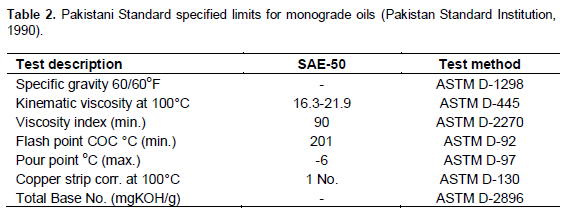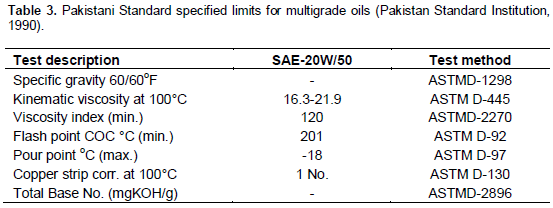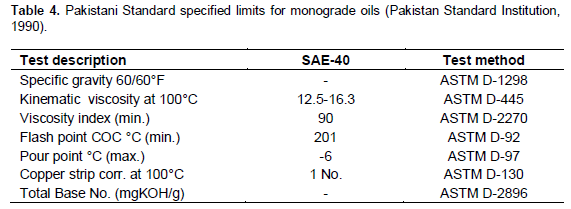ABSTRACT
In this study, physicochemical characteristics of Pakistani fresh and used monograde (SAE-40, SAE-50) and multigrade (SAE-20W/50) engine oils have been studied. The samples were analyzed for specific gravity at 60/60°F, kinematic viscosity at 100 and 40°C, kinematic viscosity index, pour point, flash point, total base number, copper strip corrosion and sulphur contents following the ASTM (American Society of Testing and Material) standard methods. Five samples of automotive lubricating oils of different API (American Petroleum Institute) grades as mentioned above were included in this investigation. Samples were taken from the sumps of five different engines, that is, three spark engines, and two compression ratio diesel engines(one ordinary duty and other heavy duty engine oil) after covering several mileage of service (ranging from 800 to 2800 km). Results show the deterioration of the samples with increased reduction as the vehicle covers more distance with the same oil which needs to be replaced. Specific gravity increases with usage due to engine wear and induction of oxidation products. Viscosity of all samples decreases as the oil ages, which is due to lighter end contaminants. Pour point of monograde oil slightly decreases with usage but no change in pour point was found in more stable multigrade oil. Flash point and Total Base number decreases depending upon the usage of oil. Sulfur contents of used oil were recorded higher because of the presence of wear caused between the moving parts as the oil strength decreases with increased usage which then cannot prevent the friction among the moving parts of the engine.
Key words: Physico-chemical, characteristics, used engine oil, Pakistan.
Lubricating oil may be defined as the petroleum products that reduces the friction among the metal parts of the engine and keeps it smooth (Jonathan, 1993). Oils from the automotive sources consist multi and monograde crankcase oils from diesel and petrol engines along with the lubricants of industrial grade (Gergel and La, 1977).
Lube oils become viscous liquids and are used to lubricate moving parts of machines and engines. Generally, these hydrocarbons which range from low viscosity oils having molecular weights as low as 250, up to very viscous lubricants with molecular weight as high as 1000 (Heitzman et al., 1985). They also serve to remove automotive parts wear, created by moving surfaces, in this way heat is removed from working parts in machinery and form a protective layer at the surfaces of metals so that corrosion may be avoided. Lube oils are prepared by blending different viscosity-based oils with suitable proportion of additives.
Base oils may be synthetic material manufactured by chemical processes or can be derived from crude oil (Jha, 2005). For a particular vehicle the selection of lubricant is not only based on its stability to reduce friction and wear but also on properties of additives which are being added in the blended base oils (Kinghorn, 1983). Lube oils help to protect rubbing surfaces when used in service, they also help to protect internal metallic friction of the machinery and promote easier motion of connected parts. In the process, they have potential to remove high buildup of temperature on the moving surfaces. Moreover, continuous exposure to build up of temperature decreases the quality of lubricating oils. This may lead them to reduce important properties such as: specific gravity, viscosity, etc. Sometimes, worn out metal parts and from the surfaces are directly deposited into the lubricating oil. Lubricating properties of lube oils are decreased with prolong usage. This is because of over-reduction of desired properties. At this point oil needs to be replaced with fresh one. The disposal of lubricating oils has now become a major problem as large amount of engine oils are used annually, The issue of environmental pollution because of waste or used lubricating oils has been addressed carefully in advance countries (Cooke, 1982). Each year USA generates almost 2 billion gallons of oils (Coyler, 2000). This stimulated government and industries to find out successful solutions that in turn will reduce environmental pollution and the used lubricating oil may be dumped off in an environmental friendly manner (Whisman et al., 1978).
Lubricating engine oils are exactly known by Society of Automotive Engineers (SAE) number having different API (American Petroleum Institute) grades. The SAE grades of oil on the basis of viscosity are being used by manufacturers of most automotive equipment which they recommend for use in their products. As SAE number increases, the viscosity of oil also increases and the oil becomes heavier as well (Scapin, 2007). The addition of certain additives is for the improvement of viscosity- temperature characteristics. This study investigates physic-chemical characteristics of the engine oils being used in different vehicle engines in Pakistan.
Engines
Five types of the internal combustion engines (three spark ignition and two compression ignition) were used to examine the ageing of the lubricating oils and their harmful effects on the engines. The oil properties from a brand new Honda CD-70 motorcycle (engine no.6821353), six months’ old Corolla car (engine no. Z 222420), 7 years old Cultus car (engine no. F 382877), a two years old vegan (engine no. 428411) and a ten years old tank lorry (engine no. 199132) engine oils were studied in this research. Used oil samples were taken after average service covering 1000, 2400, 2200, 2000 and 1400 km, respectively.
Methods
Standard methods were applied for the physical parameters like specific gravity at 60/60F, Kinematic viscosity at 100 and 40°C, Viscosity Index, Flash Point, Pour Point, Total Base Number and sulfur contents which were determined by following Standard Methods D-1298, D-445, D-2270, D-92,D-97, D-874, IP-63, and ASTM D-2896 respectively (ASTM Standards, 1999).
Equipment
The equipment used for this study are listed as follows: Hydrometer no.886653, B.S. 718, made in USA was used for Specific gravity, Viscometer bath (VHC-220, GALLENKAMP, England) for kinematic viscosity at 100 and 40°C, Semi-Automotive Cleveland Open Cup DIN-51376, LAUDA, Germany) for flash Point, Graguated 80 ml jar with thermometer No.108 MM IMM IP 1C/ASTM 5C, 5608 Seta for pour point, X-ray analyser (Model no. 15062, USA) for sulfur contents and 960-Autochemistry, ORION, Japan for TBN.
Samples collection
The brands of lubricating oils used were monograde automotive mobil oils, that is,
1. Sun Bonus 150, SAE-40 (API-SC/CC)
2. Gold Spectra-D, SAE-50 (API-CC/SD)
3. Servo D-4 SAE-50(API-CD/SE) and multigrade automotive mobil oils i-e
4. Zelax Gold, SAE-20W/40 (API-CG4/SG)
5. Servo PC-6, SAE-20W/50 (API-SG/CF4)
These samples were taken from the sumps of five different engines after covering certain mileage with the same oil brand.
Results of the physical parameters of used and fresh lubricants are presented in Table 1. Discussion on results obtained is as follows.
Specific gravity (ASTM D-1298)
Specific gravity may be defined as the ratio of density of unknown sample to the equal volume of water. It has been observed that the specific gravity of used lubricating oils was higher than the fresh ones. This may be due to the contamination of used samples by the high molecular weight components from inside the engine.
Kinematic viscosity (ASTM D-445)
Viscosity is temperature dependent parameter. It is defined as the resistance offered to flow of the liquid. The Kinematic Viscosity was measured at 100 and 40°C and the results were compared to the specified limits of Pakistan Standard Institution (PSI) (1990), which is shown in Tables 2, 3 and 4, however, viscosity at 40°C is not specified by PSI. It has been observed that the viscosity of the samples go on decreasing as the sample is used for longer time. This may be due to the contamination of lighter end hydrocarbons which render the oil unfit to be used any more.



Viscosity index (ASTM D-2270)
Viscosity Index is being used in practice as a single number indicating temperature dependence of kinematic viscosity. Viscosity Index of used oil samples was greater than fresh ones due to thermal oxidation.
Flash point (ASTM D-92)
ASTM books define the flash point of petroleum products as the minimum temperature at which the vapours of the oil start to catch fire. The results indicate that the flash point of the samples decreases with the usage of the oil. This is due to combination of lighter end organic contaminants in the used oil samples.
Pour point (ASTM D-97)
The lowest temperature at which the flow of the liquid ceases to exist is called pour point. Apparently, the pour point of the samples was same after usage this indicates the oils capability to be reused/recycled after purification. The results of the samples show slight decrease of pour point in monograde (SAE-40 and 50) oil samples after use whereas no significant change in pour point was observed in multigrade (SAE-20W/50) oil samples. This is because SAE-20W/50 is a high viscosity, high grade engine oil having higher percentage of additives. The temperature of the sample was recorded when there was no flow.
Copper strip corrosion (ASTM D-130)
This method covers the corrosion of copper strip when it is kept in lubricating oil and certain other petroleum products. All samples mentioned in Table 5 were subjected to this test and the results have been presented in Table 1 which show that the fresh samples were included within the specified limits of Ministry of Petroleum and Natural Resources, however, the used samples of monograde oil show greater tarnish as compared to multigrade oil samples which were slightly tarnished due to their greater stability.
Total base number (ASTM D-2896)
Total base number is the neutralization number which is a measure of the alkalinity of oil. The results as summarized in Table 1 show that all the fresh samples fall in the range of monograde and multigrade automotive engine oils but the used samples show greater deviation from the standard limits.
Sulfur contents (ASTM 1552)
This method is for sulfur analysis. Sulfur demonstrates degree of oxidation and corrosion of oil samples. The sulfur contents of used lube oils are higher than the fresh ones as given in Table 1. This is because the existence of wear and tear caused between moving parts of the engine. The compounds of low melting point are formed after the reaction of sulfur that are readily sheared without catastrophic wear. Corrosion in engines occurs due to the mineral acids which are formed by the oxidation of sulphur compounds in fuel in internal combustion engines with refined oils; those hydrocarbons that were inherently unstable have been oxidized during use (Rincon et al., 2005).
It may be concluded that properties of the lubricating oils change with longer usage inside spark engine as well as compression ratio diesel engines. However, there is no change in the pour point of multigrade oil samples which indicates that the oil can be reused after recycling and reprocessing. The monograde engine oil needs to be changed after covering 1600 to 2200 km, but motorcycle oil should be used for 800 to 1000 km whereas multigrade engine oils need to be changed in above mentioned vehicles after covering 1400 to 2200 km so as to avoid any damage of engine parts. It will allow the machinery to work smoothly. Otherwise the engine parts would be expired before reaching their actual life. It has been observed that the life of the engine oil expires much quickly in heavier vehicles as compared with lighter ones.
The authors have not declared any conflict of interests.
The work presented in this paper is a part of Ph.D. dissertation of Mr. Muhammad Qasim. The authors are thankful to Mr. Muhammad shafeeq, Director General of Hydrocarbon Development Institute of Pakistan for technical support.
REFERENCES
|
ASTM Standards (1999). Petroleum Products Lubricants and Fossil Fuels, Section-5, V 05. 01 and 5. 02. American Society for Testing and Materials, Philadelphia, USA, Publication Code No, (PCN): 01- 050289- 12.
|
|
|
|
Heitzman PE, Bertholot JP, Hopper WC, Pollit AD, Smith JD, Vickers BG (1985). The collection, disposal and regeneration of waste oil and related materials. Concawe report 85:53.
|
|
|
|
Cooke VB (1982). The Role of Additive in the Automobile Industry, ASLE -1982.
|
|
|
|
Coyler CC (2000). Gasoline Engine Oils: Performance, Evaluation and Classification. 10th World petroleum Congress, Moscow, 112 p.
|
|
|
|
Georgel WC, La TGG (1977). Extended engine oil life through new technology. In Seminar paper at the National Petroleum Refiners Association 1977 Annual Meeting, Mar pp. 27-29.
|
|
|
|
Jha MK (2005). Re-refining of used lube oils: An intelligent and eco-friendly option. Indian Chem. Eng. 47(3):209-211.
|
|
|
|
Jonathan T (1993). Introduction to Environment Studies, 3rd Edition Saun-ders College Publisher, New York, 23:41.
|
|
|
|
Kinghorn RRF (1983). An Introduction to the Physics and Chemistry of Petroleum. Wiley and Sons. New York.
|
|
|
|
PSI (1990). Pakistan Standard Institution. Ministry of petroleum & Natural Resources, Govt. of Pakistan No. PL- L(870)/99/Spec.
|
|
|
|
Rincon J, Canizares P, Garcia MT (2005). Regeneration of used lubricant oil by polar solvent extraction. Ind. Eng. Chem. Res. 44(12):4373-4379.
Crossref
|
|
|
|
Scapin, M. (2007). Recycling of used lubricating oils by Ionizing, linking hub.Elservier. com/retrieval/pii/30969806X0700182X.
|
|
|
|
Whisman ML, Reynolds JW, Goetzinger JW, Cotton FO, Brinkman DW (1978). Re-refining makes quality oils. Hydrocarbon Process 57(10):141-145.
|